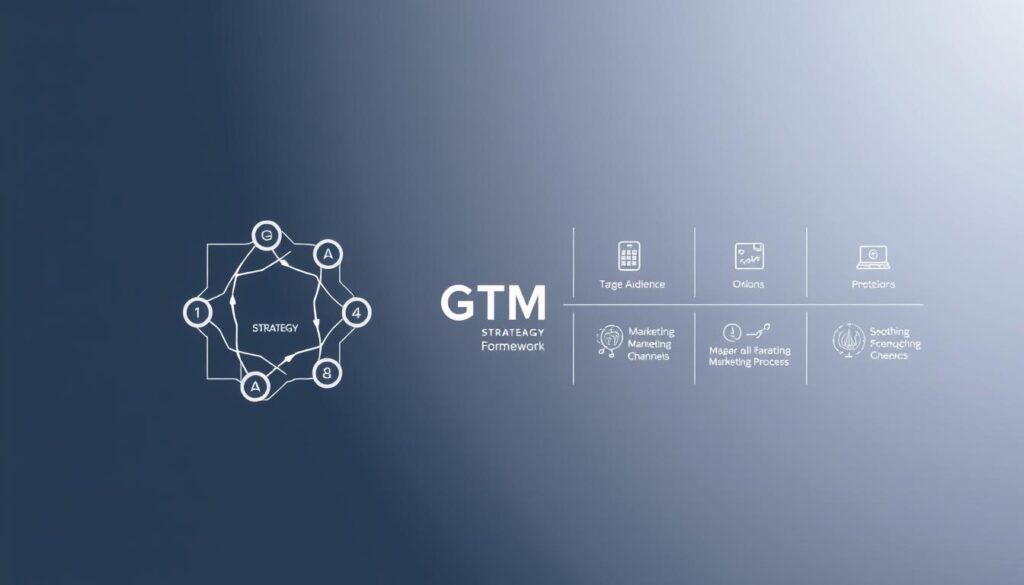A well-crafted GTM strategy acts as a roadmap for launching products or entering new markets. Unlike broad marketing strategies, this approach zeroes in on specific initiatives with surgical precision. It answers critical questions about positioning, pricing, and delivery channels before competitors even recognize emerging opportunities.
Modern businesses operate in markets where 72% of new offerings fail within 12 months. Structured market strategies reduce this risk by aligning cross-functional teams around unified objectives. They transform abstract concepts into actionable plans that resonate with target audiences.
The digital age demands more than traditional promotional tactics. Successful companies integrate customer insights with operational capabilities, creating launch plans that adapt to real-time feedback. This agility separates market leaders from those struggling to gain traction.
Key Takeaways
- GTM plans require 53% less adjustment post-launch compared to unstructured approaches
- Effective strategies blend competitive analysis with behavioral economics principles
- Digital channels now influence 89% of successful product introductions
- Cross-department alignment improves execution speed by 41%
- Companies using formal frameworks see 3.2x faster market penetration
Understanding the Go-to-Market Landscape
Effective market entry hinges on a meticulously designed strategy that aligns multiple business functions. Unlike broad initiatives, GTM strategies act as precision instruments, coordinating product positioning, distribution channels, and customer insights into a unified blueprint. These plans transform market knowledge into actionable steps, addressing critical things like competitor responses and regulatory hurdles.
What Defines a GTM Strategy
A true GTM strategy merges operational capabilities with real-time market intelligence. It requires product teams to collaborate with sales and marketing departments, ensuring every launch element addresses specific customer needs. Key components include:
- Competitor response predictions
- Regulatory environment assessments
- Adoption cycle analysis
This approach grounds decisions in data rather than assumptions, as detailed in this comprehensive go-to-market framework.
Differentiating GTM from Traditional Marketing
While marketing strategies build brand awareness, GTM plans focus on tactical execution. Traditional methods might prioritize long-term campaigns, but market entry strategies demand precise timelines and resource allocation. For example:
- GTM: 6-month launch roadmap with defined metrics
- Traditional: Annual brand awareness initiatives
This distinction ensures companies allocate budgets and personnel effectively during critical launch phases, prioritizing measurable outcomes over broad things like vague awareness goals.
Boosting go to market online visibility for Digital Success
Today’s ecommerce environment grows more competitive daily. Over 60% of businesses report increased difficulty capturing attention since 2022. Precision tactics now separate thriving brands from those lost in the noise.

Improving Ranking and Audience Reach
Data shows companies using integrated SEO approaches achieve 47% higher conversion rates. One study found:
“Brands combining technical optimization with behavioral analytics see 3x faster SERP improvements than those focusing solely on keywords.”
Effective methods include:
- Semantic keyword clustering for topic authority
- Mobile-first indexing optimizations
- User intent mapping through heatmap analysis
Optimizing Your Digital Footprint
A cohesive presence requires aligning multiple channels. Compare core components:
| Channel | Focus Area | Key Metric |
|---|---|---|
| Website | Core Web Vitals | Load speed ≤2s |
| Social Media | Engagement patterns | 4-7% CTR |
| Personalization depth | 32% open rate | |
| Content Hubs | Search intent match | 70%+ dwell time |
Regular audits identify gaps between channels. Brands updating their content ecosystems quarterly see 28% higher retention than annual reviewers. Real-time analytics enable swift adjustments to shifting consumer behaviors.
Defining Your Target Market and Ideal Customer Profile
Pinpointing the right audience transforms theoretical strategies into revenue-generating engines. Research reveals B2B purchases involve 6.8 stakeholders on average, each with distinct priorities. As Harvard Business Review notes:
“Organizations that map decision-making units achieve 37% higher conversion rates than those using generic outreach.”
Market Segmentation and Total Addressable Market
Effective segmentation digs deeper than job titles or company size. Strategic teams analyze purchase triggers, operational challenges, and even team dynamics. For example, a CFO’s cost-saving priorities differ radically from an IT director’s security concerns.
Calculating total addressable market requires cross-referencing industry reports with real-world buying patterns. One healthcare SaaS provider discovered 42% of their presumed target market lacked budget authority – prompting a shift to department-level decision makers.
Building Detailed Buyer Personas
Sophisticated profiles blend behavioral data with psychological drivers. A manufacturing equipment supplier found maintenance managers valued reliability 3x more than price – insight that reshaped their entire customer engagement strategy.
Regular persona updates prove critical. After analyzing 12,000 deals, a CRM platform adjusted their messaging to address legal teams’ compliance concerns – boosting close rates by 19% in regulated industries.
Developing a Compelling Value Proposition
Crafting an irresistible value proposition requires dissecting what truly matters to your audience. Research shows 83% of buyers prioritize solutions addressing specific pain points over generic offerings. This demands more than surface-level analysis – it’s about uncovering hidden frustrations competitors overlook.

Differentiating Your Offer
True differentiation emerges when customer needs guide product development. A fintech company increased conversions by 34% by focusing on real-time fraud alerts competitors lacked. Effective strategies often combine:
- Usage pattern analysis from support tickets
- Competitor feature gap assessments
- Pricing model innovation
This approach transforms technical capabilities into tangible benefits like time savings or risk reduction.
Communicating Key Customer Benefits
Clear messaging bridges the gap between features and outcomes. As one CXO noted:
“Our clients don’t buy software – they buy confidence in meeting compliance deadlines.”
Successful teams use customer journey maps to identify decision-making triggers. Case studies showing 42% faster workflows or 19% cost reductions prove more persuasive than generic claims.
Regular A/B testing ensures messaging evolves with market shifts. Brands updating their value proposition quarterly see 27% higher engagement than annual revisers.
Crafting Messaging, Positioning, and Differentiation
Clear communication bridges the gap between products and buyers. Companies that align their verbal and visual language across departments see 68% higher brand recall. This synchronization turns fragmented interactions into cohesive experiences that guide purchase decisions.
Creating Consistent Brand Messaging
Unified communication requires documented guidelines covering tone, terminology, and core promises. A SaaS company increased conversions by 22% after training sales and support teams to use identical success stories. Key elements include:
- Centralized message repository for all teams
- Quarterly alignment workshops
- Cross-channel content audits
| Communication Channel | Key Element | Success Metric |
|---|---|---|
| Sales Calls | Value articulation | 87% message alignment score |
| Marketing Content | Audience relevance | 4.1/5 content score |
| Customer Support | Problem framing | 92% issue resolution rate |
Establishing Competitive Positioning
Differentiation begins by mapping competitor weaknesses against your strengths. A retail analytics firm gained 31% market share by emphasizing real-time inventory tracking – a feature 79% of rivals lacked. Effective strategies involve:
- Quarterly competitor message analysis
- Customer perception surveys
- Unique value indicator tracking
As one chief strategy officer noted:
“Our buyers choose us because we address unspoken operational fears competitors ignore.”
Continuous monitoring helps teams adapt to shifting preferences. Brands updating positioning frameworks every 90 days maintain 2.3x higher relevance scores than annual revisers.
Building a GTM Strategy in Ecommerce
Ecommerce demands strategies that convert browsers into loyal buyers. Physical product sales introduce hurdles requiring specialized approaches – from inventory risks to fleeting customer relationships. A tailored GTM strategy addresses these digital-specific challenges while maximizing long-term value creation.
Solving Core Operational Challenges
Low customer lifetime value and 70% cart abandonment rates plague many online businesses. Strategic solutions combine conversion science with operational agility. Membership-based pricing models, for instance, boost repeat purchases by 33% compared to one-time transactions.
Proactive cart recovery tactics paired with real-time inventory tracking reduce lost sales. Brands using targeted traffic strategies see 28% lower acquisition costs while maintaining quality lead flow.
Exceptional service remains non-negotiable. Companies resolving issues within 4 hours achieve 19% higher retention than those taking 24+ hours. This operational excellence turns first-time buyers into brand advocates, directly combating the CLTV challenge.
By aligning these tactics with broader market goals, ecommerce leaders build sustainable growth engines. The right strategic mix transforms digital obstacles into competitive advantages.
FAQ
How does a go-to-market strategy differ from standard sales tactics?
A go-to-market strategy combines product positioning, audience targeting, and cross-channel execution into a unified plan. Unlike isolated sales tactics, it aligns pricing models, customer experience design, and content distribution for sustained market penetration.
What metrics prove effective online visibility in GTM execution?
Key indicators include organic search rankings for solution-focused keywords, referral traffic from industry platforms like G2 or Capterra, and engagement rates on thought leadership content. Successful strategies often show improved conversion rates across multiple touchpoints.
Why do buyer personas require constant refinement?
Market conditions and consumer preferences evolve rapidly. Regular analysis of sales call recordings, support tickets, and behavioral data from tools like HubSpot ensures personas reflect current pain points and decision-making criteria.
Can startups benefit from enterprise-level GTM frameworks?
Absolutely. Modified versions of frameworks like SiriusDecisions’ Demand Waterfall help startups prioritize high-impact activities. The focus shifts to rapid validation of value propositions through platforms like Product Hunt or LinkedIn communities.
How does pricing strategy impact market positioning?
Pricing models directly communicate perceived value. Tiered pricing with clear feature differentiation, as used by companies like Salesforce, helps segment audiences while reinforcing competitive advantages through structured benefit comparisons.
What role does customer experience play in retention strategies?
Post-purchase engagement drives 65% of repeat business according to McKinsey data. Automated nurture sequences, personalized through platforms like Intercom, turn transactional relationships into collaborative partnerships that fuel organic growth.



